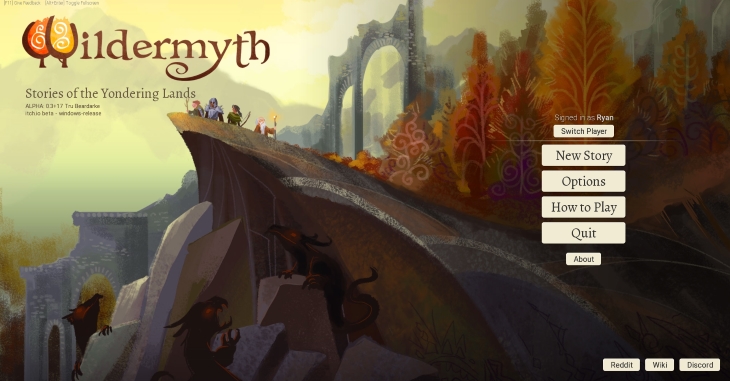
We recently talked about Wildermyth’s beta being available to buy right now, and were soon after graced with a copy to share our thoughts on it. As a procedurally-generated RPG where even the story can be randomly generated, did we get lucky? Read on to find out.
Clearly, as mentioned, many things Wildermyth are randomly generated. You form a party of (random) heroes with (random) backstories, who learn (random) abilities based on their class. You then travel a (random) world map, and experience (random) events while taking out a major threat of one of five (random) groups of enemies- with three others scattered in.
The combat has your party (up to a maximum of five) clear out enemies in a small map. Everyone gets two action points, which they can spend to move or perform an action. While you can move twice, the majority of attacks end that character’s turn.
Characters and enemies also have armor and health values, similar to Banner Saga, though you cannot attack armor directly (“shredding” being a side-effect of some attacks), and there is warding for magic. Characters can also stand beside one another to grant each other an extra point of armor.
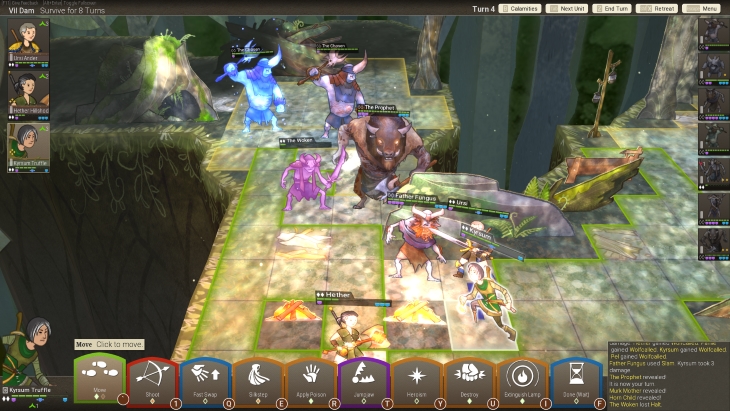
In addition, you can flank enemies for 100% accuracy by attacking them from a different side than where they were last attacked from. As the 2D “paper-standee” style characters can only face left or right, it’s hard to tell at a glance what their current facing is. You can still work out quite quickly by highlighting the surrounding squares however.
The character classes are warriors, hunters, and mystics. The typical fighter, rogue, wizard affair is somewhat broken by the mystic however. Mystics must “infuse” with objects from the environment, granting buffs or special attacks- such as making wooden objects explode into splinters or throwing fire from a lamp.
The issue is that when a character levels up, they can choose one of three random abilities. As such, how well your party is developed is literally up to chance. While I never struggled to make a competent party, I wasn’t as invested in my characters because of it.
A playthrough can be short. A three chapter playthrough takes an evening- though five chapter campaigns are available. Despite this, once I realized I could use hyper-aggressive tactics (attempting to kill a foe before they could cause any harm to my party) I could breeze through most battles on normal difficulty for the first three chapters. It was low HP and high damage on both sides, but I still grew bored.
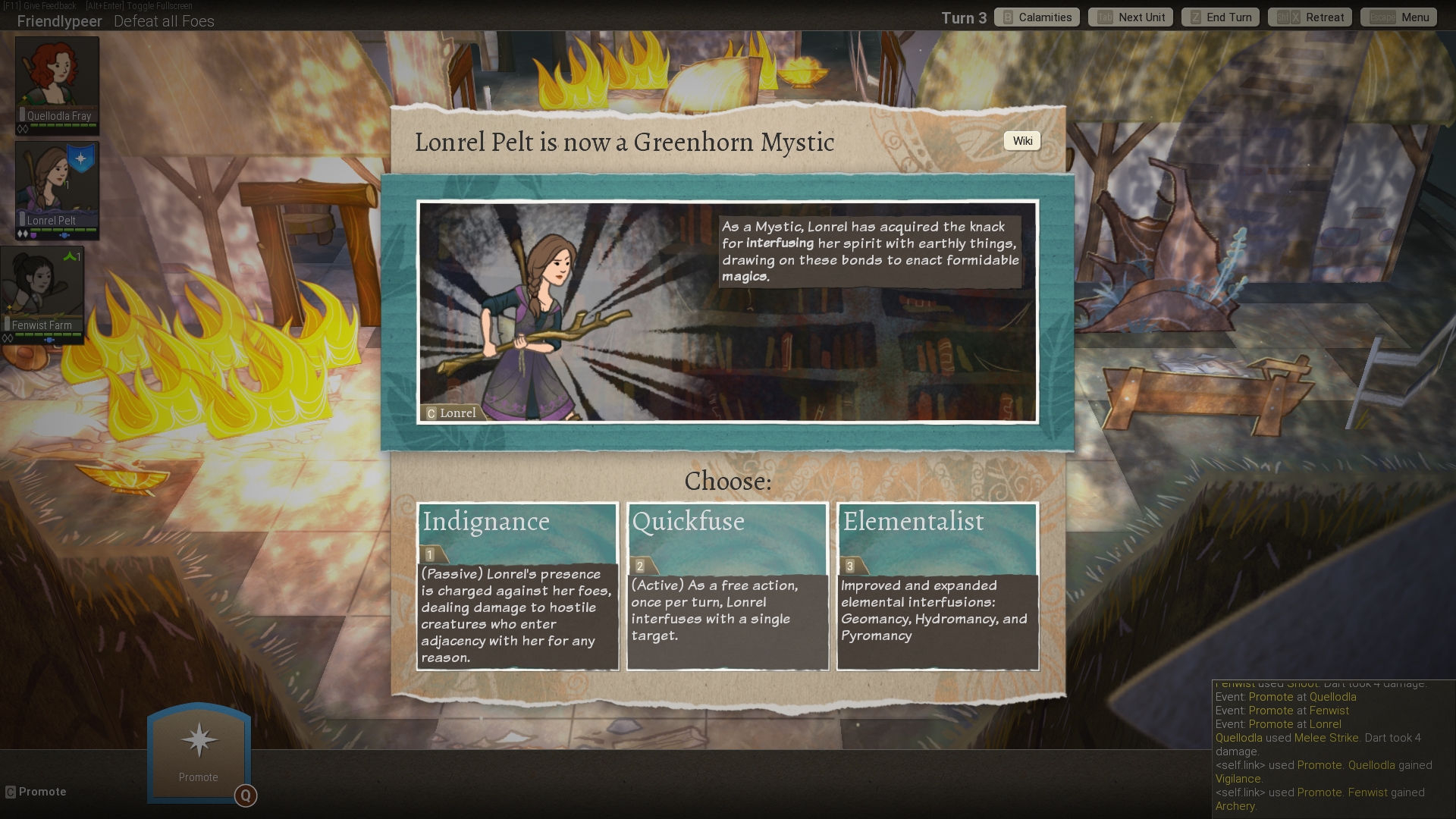
Some abilities are overpowered to boot. Warriors get the ability to lash out once when an enemy approaches them. Combined with the ability to let this happen repeatedly, a well-armed warrior becomes a meat-grinder.
Hunters can also gain an ability to turn invisible when they kill, or make enemies flankable from all sides. Mystics have a chance to learn to Infuse as a free action once per turn. While I must emphasize due to the random nature of the game that discussing balance is more difficult, those abilities still felt broken.
When I turned up the combat difficulty to hard, I soon found a real challenge early on. It certainly feels like no matter the difficulty, once you get some decent abilities on characters you steamroll the rest of the campaign rather quickly.
The same applies to equipment rewarded to you after battle or an event. This is made worse by being unable to trade gear; once it is assigned to a character it is locked to them. While the different types of weapons did perform differently, I had no control over what everyone got aside from crafting gear between chapters.
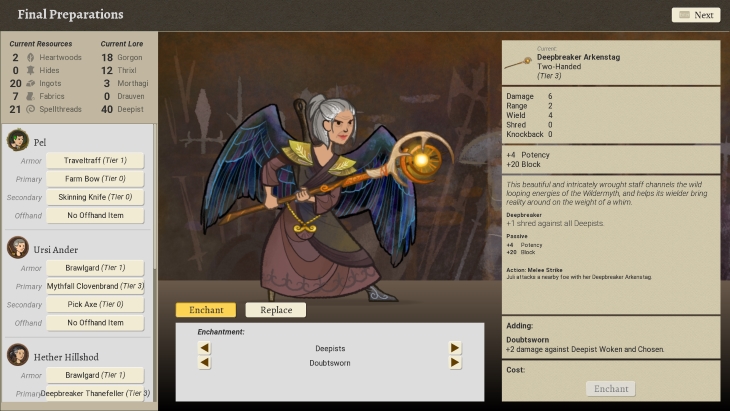
You can craft weapons and armor with resources from lands you controlled by the end of the chapter. You can even enchant weapons to shred armor, to be more accurate against an enemy faction, or do more damage to an individual species.
While you battle four out of five possible enemy factions, I never found myself needing the enchantments. I was killing most enemies the turn they appeared if I had the chance, so I usually chose armor shredding or accuracy for the major enemy faction, which was fairly cheap anyway.
While I was always able to form a party of competent characters, there were times a character would simply become useless if they didn’t get the kills, their abilities didn’t gel, or I kept giving gear to better characters. Thankfully, letting a useless character die can be helpful.
When a character dies, they can either sacrifice themselves to deal a ton of damage to an enemy, grant allies more armor, or retreat and lose a limb. I usually saved them if they were competent fighters, and rarely felt (on normal difficulty) that a battle was so desperate I needed the other options. Even with a lost leg or arm, their abilities and items still made them good fighters.
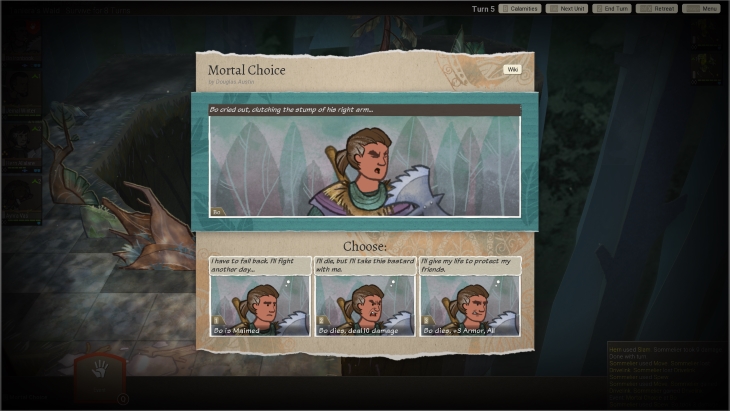
There are many ways through events to recover limbs- and they can bring about some interesting changes. From necromancy steampunk arms that give you an built-in crossbow to attack with, to tree like root legs to prevent knockback on attacks.
If Characters survive a campaign (or you make them a tomb), they are added to a “legacy” roster. Legacy characters can be hired in future campaigns at the cost of more “Legacy Points”- your major currency (earned for winning battles and some events). One character per completed campaign can also become a legendary hero, and can turn up in events in other playthroughs.
The world map takes cues from Civilizations and Risk. Characters travel over a series of days, and take several days to complete tasks. These include scouting an area, building up defenses for invasions, or making an area habitable to gain resources for crafting.
While on a far smaller scale, the challenge of where to put my characters and considering traveling time did take me back to Civilizations. Though by chapter three I usually had enough party members to warrant splitting up the party- or needed to.

The map grows larger each chapter, and from chapter three onwards I usually had to tackle different areas of the map at once to deal with multiple areas to explore or deal with a sudden invasion. Time is of the essence due to “calamities” and invasions.
The more time passes, the more calamities happen. These add new monsters to a potential line-up of enemies you fight. Along with increasing the different types of monsters within a faction, it also can increase the number of units per battle, improve their stats, or grant them new abilities.
Clearing a battle adds one calamity. Calamities added while traveling come in two and you can cancel them with legacy points. After clearing a chapter, several random power-ups are removed. Overall this provided a good escalation in enemy power that wasn’t too quick or too slow.
In addition, areas can be “invaded” by monsters from nearby unexplored locations. This stops you getting the resources at the end of a chapter, and makes it likely you’ll be ambushed when walking across those lands. You’ll also have to battle in it again to liberate it, then repair the damage.
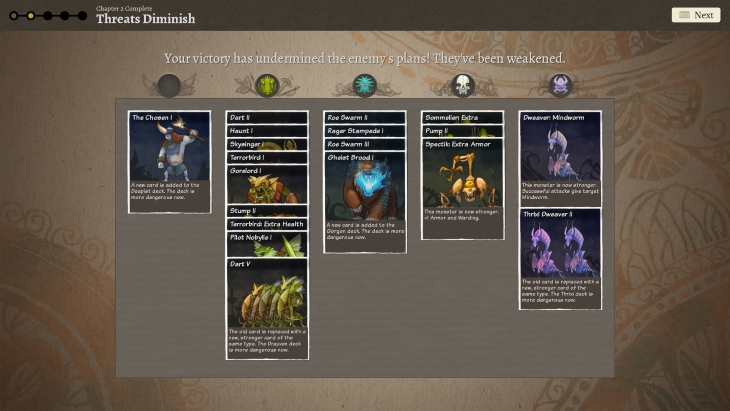
The game’s combat and overworld difficulties are independent, meaning calamities and invasions happen more or less frequently. I never had to leave heroes to stand guard on normal difficulty, and usually sent a party back to defend or reclaim territory. On harder difficulties, it did get difficult to constantly hold down the whole map, and I had to choose what was relinquished.
While legacy points are usually spent on preventing monsters getting stronger, they can also be used to develop land on specific tiles, or hire new characters (which you can train in any class). Rather curiously, new characters could still hold their own even in later chapters- as long as they became decently armed.
Likewise, if you have a character from an older run you really want to use again, you can spend more legacy points to hire them. You can even choose to omit certain personality traits and abilities to reduce the cost. I never found myself needing to do so, but it is a nice option.
The balance of acquiring legacy points does seem off for longer campaigns. Items you earn can be left behind to gain a legacy point. So, unwanted gear (be it too weak or not fitting any hero’s playstyle) quickly became a way to build up legacy points fast.
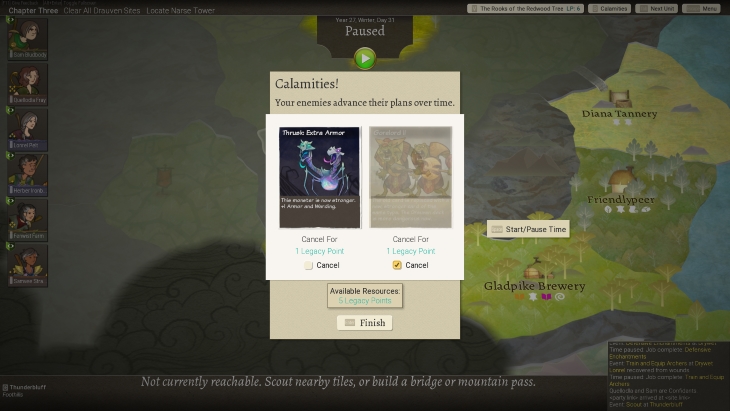
While fine for a three chapter campaign, by the fourth chapter of a five chapter campaign I had built up legacy points into the twenties. Considering new characters cost two, and cancelling a calamity costs one, it’s fair to say you get too on longer normal difficulty campaigns.
Of course, being a beta there were several gameplay bugs. From the minor such as you character’s history suddenly omitting certain keywords (“Her village was attacked by <Monster>”) to a character who had survived the final battle of a chapter suddenly dying at the start of the next one.
When an event had reduced enemies’ HP a little, the low health enemies somehow had zero HP. They still died with one hit though. In addition, gaining the same “Aspect” twice (a personal trait that can affect events and slightly affect stats) caused that Aspect to be removed. Finally, rerolling an individual character out of your starting characters rerolls all of them.
While beta bugs are forgivable, I did have some minor gripes. You can’t swap a character’s primary and secondary weapons outside of battle. Being this costs an action point during battle, it seems unfair. In addition, the hit chance seems to fluctuate as you highlight an enemy. I deeply hope this is not real and just a dog and pony show, but even as a stylistic choice it’s more annoying than tense.
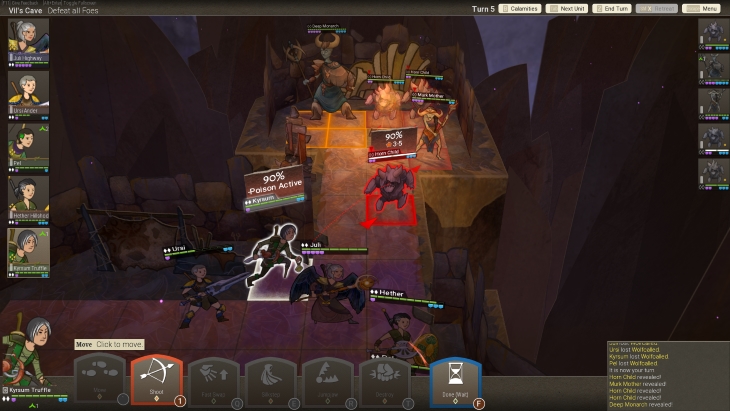
Some abilities also weren’t very well explained. Some mystic skills needed to invoke two objects made of the same material, and “Battledance” grants warriors the ability to use all their attacking abilities with no action cost – except their main attack.
As this is a beta, I have full faith these will be fixed or improved release. On paper they sound like reasonably simple fixes. For now they are little quirks that can be dealt with in stride. I did have one random crash, but the game’s autosave is very frequent and uses multiple slots.
The same applies to issues I had with the game’s difficulty balance. While saying “I got bored” sounds like utter condemnation, I believe difficulty balance and some abilities will be reworked.
Not to mention my times in longer campaigns ramped up the difficulty and tension in the final two chapters. Whether the final game is best enjoyed in short easier sessions, or as a fine-tuned longer campaign remains to be seen.
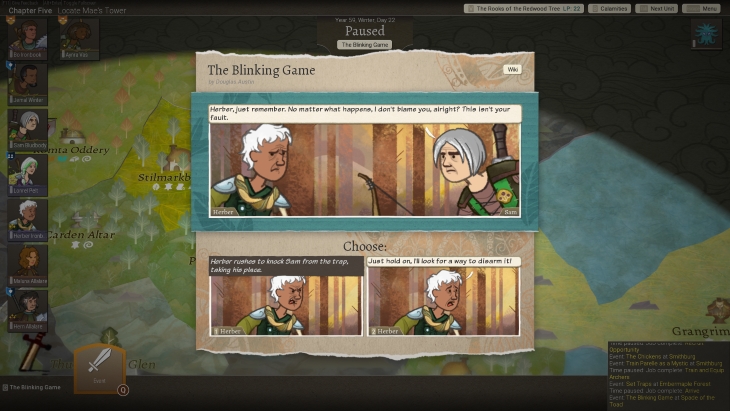
The story is very basic but not structured in the traditional sense. The world is being assaulted by evil forces, and your initial party of three wants to stop it. How this evil came about is never explored. The focus is more on the random events your characters come across when traveling or liberating areas.
You then can make one of several choices during an event, and that choice for that event will usually play out the same every time. However, certain character personality traits (or “hooks” – determined by their backstory), can give new choices.
In the hours I played it, I did encounter a few repeat events on other playthroughs. I chalk this up more due to the random nature of the game, and how the beta may have fewer options than the full game (but still many).
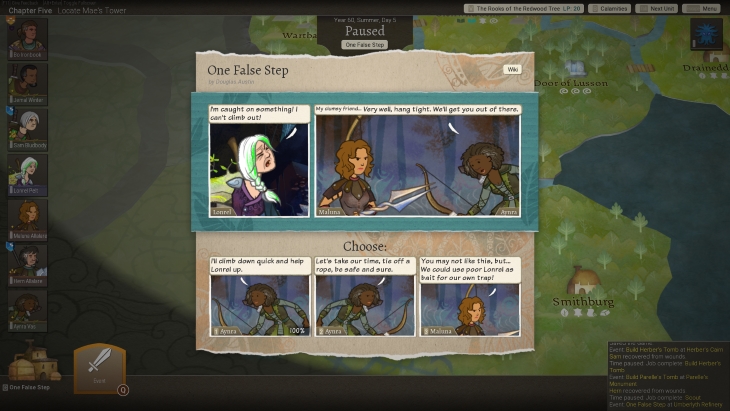
It exposes how once you learn what the choices do, you can learn what benefits that character most- such as getting new gear, positive aspects, or advantages in upcoming battles; there were one or two rare events that had seemingly no positive outcome.
The other thing that surprised me was how varied the dialogue could be. In the rare chance I did get the same event twice, the dialogue was still very different. A character’s hooks do change some dialogue. While not memorable, I was surprised when one of my characters who was an orphan said “I never knew my parents, but you should get to know yours”.
The events that happened to the characters tended to be more memorable than the characters personalities on their own. I can’t remember the name of my first mystic. I do remember he was a hopeless romantic who finally fell in love with a nymph, and was destined to become a celestial tortoise guarding the cosmos when he died.

Another character gained crows wings after submitting to the will of some strange witch-woman, while another who rejected her ended up having to fight her instead. A character who had a splinter grew green hair thanks to her “elmsoul,” and grew tree-like limbs when she lost them. One man called Spike gained the head of a wolf.
The events that change your character’s appearance or grant them special equipment are the most memorable, but that’s not to say they are limited to just that. I had to make the difficult choice to nurse a lizard-man child back to health or let it die, and another met their estranged father. In short, the events were very well written, though the humor can be a little dry and quirky for some.
There was the odd error here and there (sentences ending suddenly), but nothing that can’t be fixed. One curiosity I found was in some events, characters on opposite sides of the map could be sharing a conversation. I am a bit of a hypocrite, as I don’t mind being able to give gear I just found to almost any character in the world.
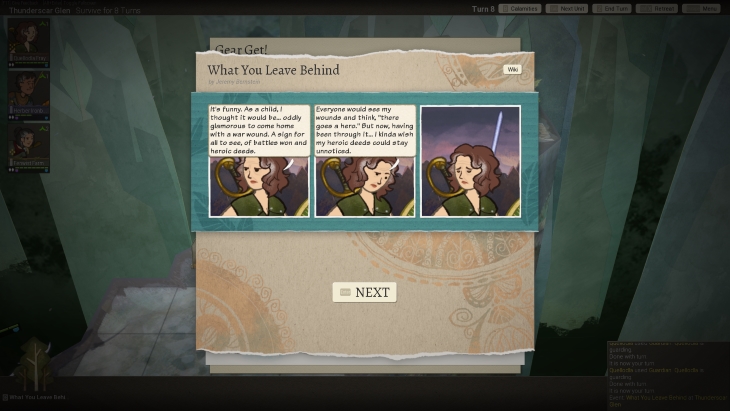
One reason I fixated on the events more than the characters is partly due to the designs. While environments and enemies can look great, the faces of the player characters are rather simple and plain.
That’s not to say they are ugly, but they are simplistic. Think Scooby Doo, Fallout Shelter, or the animated version of Karl Pilkington on The Ricky Gervais Show. Sadly some events do rely too heavily on “reaction shots,” and those exaggerated expressions on such simple faces can be ugly.
One thing that did surprise me is how your characters age. The time between chapters can be over a decade of peace, and your characters show their age. It can be shocking to see them with some grey hair in their 30s, and wrinkles as they get older still. Make no mistake- your heroes will not be young by the end of their adventure.
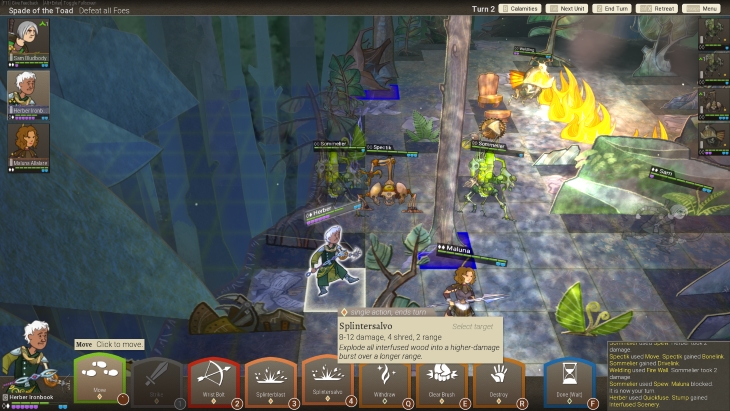
Age also plays into gameplay, with middle-age and old having a small effect on some stats and takes them longer to heal. Even though characters have a retirement age where they are supposed to stop, I had characters twelve years over their retirement age kicking around. Nothing quite like seeing an 80 year old warrior woman with white hair wielding a claymore.
The real star of the show in terms of appearance however are the monsters, as they are drawn with much more detail than player characters. The Drauven lizardmen even have minor variations in their appearance even in within the same type. A detail sadly not carried over to other factions.
While the Gorgons feature mutated animals, the Mothragi are steampunk monsters that also use bones… or necromancy that uses machinery? Either way, their non-humanoid designs are fantastic. The Thrix’ psychic-bug-dragon hybrids and cultist Deepists also look fantastic.
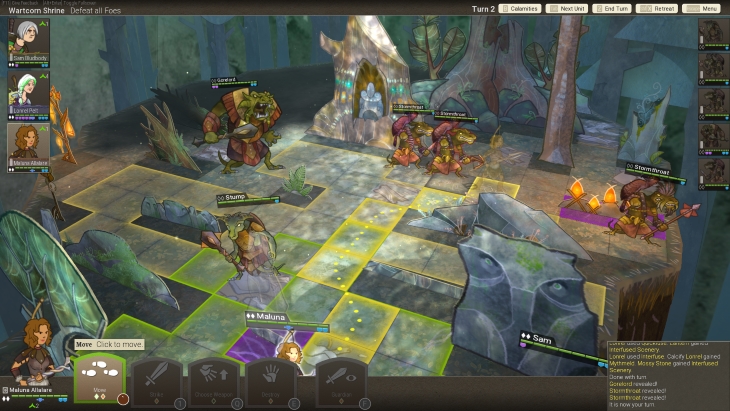
The environments themselves are very well-drawn, with enough small details to stand out despite being 2D. There was the odd asset that almost intentionally looked like it was drawn very simply, and I hope those were mere placeholders. There were also strange moments where lighting made characters “glow” almost solid white.
The game ran at 30 FPS the majority of the time, though occasionally a menu would run at a much higher frame rate. There were never performance dips however. One oddity was that the backgrounds in events could seemingly change after you made a decision (going from a forest to a cave for example).
The music is not a pulse-pounding affair for combat, but that’s fine. The ambiance of a location and even the chatter of enemies does the job just as well. Music as a whole is pretty soothing and “comfy,” especially the Celtic-style credits song that plays over what your party did after the campaign.
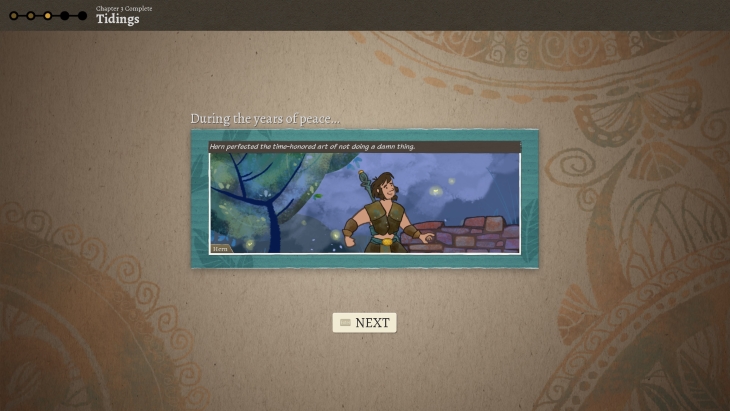
Overall, Wildermyth has massive potential to be exactly the sort of game I’ve been looking for- a randomized story with randomized characters that are all your own experience. With enough events, a few bugs and balances fixed, and something to help make your characters a little more memorable, I dare say this may be the best indie RPG the year it releases.
The Wildermyth beta is available now on Windows PC (via Itch and Steam).